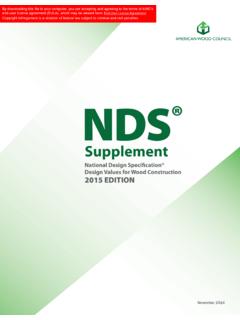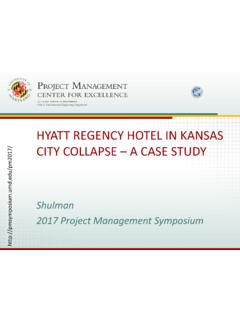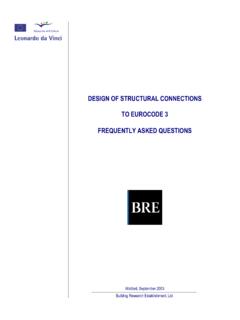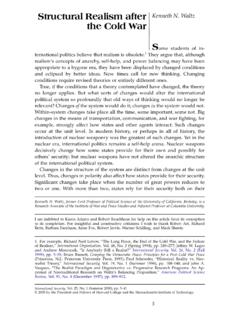Transcription of Determination of Structural Carbohydrates and Lignin in ...
1 nrel is a national laboratory of the Department of Energy, Office of Energy Efficiency & Renewable Energy, operated by the Alliance for Sustainable Energy, LLC. Contract No. DE-AC36-08GO28308 Determination of Structural Carbohydrates and Lignin in Biomass Laboratory Analytical Procedure (LAP) Issue Date: April 2008 Revision Date: August 2012 (Version 08-03-2012) A. Sluiter, B. Hames, R. Ruiz, C. Scarlata, J. Sluiter, D. Templeton, and D. Crocker Technical Report nrel /TP-510-42618 Revised August 2012 nrel is a national laboratory of the Department of Energy, Office of Energy Efficiency & Renewable Energy, operated by the Alliance for Sustainable Energy, LLC. national Renewable Energy Laboratory 15013 Denver West Parkway Golden, Colorado 80401 303-275-3000 Contract No. DE-AC36-08GO28308 Determination of Structural Carbohydrates and Lignin in Biomass Laboratory Analytical Procedure (LAP) Issue Date: April 2008 Revision Date: August 2012 (Version 08-03-2012) A.
2 Sluiter, B. Hames, R. Ruiz, C. Scarlata, J. Sluiter, D. Templeton, and D. Crocker nrel Laboratory Analytical Procedures for standard biomass analysis are available electronically at Technical Report nrel /TP-510-42618 Revised August 2012 DISCLAIMER These Standard Biomass Analytical Methods ( Methods ) are provided by the national Renewable Energy Laboratory ( nrel ), which is operated by the Alliance for Sustainable Energy, LLC ( ASE ) for the Department Of Energy. Access to and use of these Methods shall impose the following obligations on the user. The user is granted the right, without any fee or cost, to use, copy, modify, alter, enhance and distribute these Methods for any purpose whatsoever, except commercial sales, provided that this entire notice appears in all copies of the Methods. Further, the user agrees to credit nrel /ASE in any publications that result from the use of these Methods.
3 The names nrel /ASE, however, may not be used in any advertising or publicity to endorse or promote any products or commercial entity unless specific written permission is obtained from nrel /ASE. The user also understands that nrel /ASE is not obligated to provide the user with any support, consulting, training or assistance of any kind with regard to the use of these Methods or to provide the user with any updates, revisions or new versions. THESE METHODS ARE PROVIDED BY nrel /ASE "AS IS" AND ANY EXPRESS OR IMPLIED WARRANTIES, INCLUDING BUT NOT LIMITED TO, THE IMPLIED WARRANTIES OF MERCHANTABILITY AND FITNESS FOR A PARTICULAR PURPOSE ARE DISCLAIMED. IN NO EVENT SHALL nrel /MRI BE LIABLE FOR ANY SPECIAL, INDIRECT OR CONSEQUENTIAL DAMAGES OR ANY DAMAGES WHATSOEVER, INCLUDING BUT NOT LIMITED TO CLAIMS ASSOCIATED WITH THE LOSS OF DATA OR PROFITS, WHICH MAY RESULT FROM AN ACTION IN CONTRACT, NEGLIGENCE OR OTHER TORTIOUS CLAIM THAT ARISES OUT OF OR IN CONNECTION WITH THE ACCESS, USE OR PERFORMANCE OF THESE METHODS.
4 Cover Photos: (left to right) PIX 16416, PIX 17423, PIX 16560, PIX 17613, PIX 17436, PIX 17721 Printed on paper containing at least 50% wastepaper, including 10% post consumer waste. 1 Procedure Title: Determination of Structural Carbohydrates and Lignin in Biomass Laboratory Analytical Procedure 1. Introduction Carbohydrates and Lignin make up a major portion of biomass samples. These constituents must be measured as part of a comprehensive biomass analysis. Carbohydrates can be Structural or non- Structural . Structural Carbohydrates are bound in the matrix of the biomass, while non- Structural Carbohydrates can be removed using extraction or washing steps. Lignin is a complex phenolic polymer. Portions of this procedure are substantially similar to ASTM E1758-01 Standard Method for the Determination of Carbohydrates by HPLC. This procedure is suitable for samples that do not contain extractives.
5 This procedure uses a two-step acid hydrolysis to fractionate the biomass into forms that are more easily quantified. The Lignin fractionates into acid insoluble material and acid soluble material. The acid insoluble material may also include ash and protein, which must be accounted for during gravimetric analysis. The acid soluble Lignin is measured by UV-Vis spectroscopy. During hydrolysis the polymeric Carbohydrates are hydrolyzed into the monomeric forms, which are soluble in the hydrolysis liquid. They are then measured by HPLC. Protein may also partition into the liquid fraction. A measure of acetyl content is necessary for biomass containing hemicellulose with a xylan backbone, but not biomass containing a mannan backbone. Acetate is measured by HPLC. 2. Scope This procedure is appropriate for extractives free biomass, which includes biomass that has been extracted using LAP Determination of Extractives in Biomass, as well as process solids containing no extractives.
6 Results are reported on an oven dry weight basis. Results may be reported on an as received biomass basis or an extractives free basis, depending on type of biomass used. LAP Preparation of Samples for Biomass Compositional Analysis should be used prior to this procedure. This procedure is appropriate for biomass containing the components listed throughout the procedure. Any biomass containing other interfering components not listed must be further investigated. A measure of acetyl content is necessary for biomass containing hemicellulose with a xylan backbone, but not biomass containing a mannan backbone. All analyses should be performed in accordance with an appropriate laboratory specific Quality Assurance Plan (QAP). 3. Terminology Oven dry weight (ODW) the weight of biomass mathematically corrected for the amount of 2 moisture present in the sample at the time of weighing. Prepared biomass biomass prepared according to LAP Preparation of Samples for Biomass Compositional Analysis.
7 Extractives free biomass biomass after exhaustive water and ethanol extraction (refer to LAP Determination of Extractives in Biomass ). Acid insoluble Lignin the residue remaining on a medium porosity filtering crucible after a two step hydrolysis, with correction for acid insoluble ash and acid insoluble protein, if necessary. Structural Carbohydrates polymeric Carbohydrates , namely cellulose and hemicellulose. Non- Structural components non-chemically bound components of biomass that include but are not limited to sucrose, nitrate/nitrites, protein, ash, chlorophyll, and waxes. 4. Significance and Use This procedure is used, possibly in conjunction with other procedures, to determine the amount of Structural Carbohydrates and Lignin in a solid biomass sample. 5. Interferences This procedure has been optimized for the particle size range specified in LAP Preparation of Samples for Biomass Compositional Analysis. Deviation to a smaller particle size may result in a low bias in carbohydrate content (and consequent high Lignin bias) due to excessive carbohydrate degradation.
8 Deviation to a larger particle size may also result in a low bias in carbohydrate content (and consequent high Lignin bias) due to incomplete hydrolysis of polymeric sugars to monomeric sugars. Samples containing extractives are not suitable for this procedure. Extractives will partition irreproducibly, resulting in a high Lignin bias. Samples with an ash content above 10 wt % may not be suitable for this procedure, as the sample may contain soil or other minerals that will interfere with appropriate acid concentrations and may catalyze side reactions. Samples with a moisture content above 10 wt % may not be suitable for this procedure, as the excess moisture will interfere with appropriate acid concentrations. Samples should be dried (air-dried or oven dried at less than 40 C) prior to this procedure. Samples containing protein will bias the acid insoluble Lignin high unless the protein is accounted for in the gravimetric Determination of acid insoluble material.
9 An independent nitrogen analysis is required to estimate the protein content of the residue. The protein estimate is then subtracted from the acid insoluble residue measurement. Physical separation of the acid insoluble protein from the acid insoluble Lignin is beyond the scope of this procedure. This procedure is not suitable for samples containing added acid, base, or catalyst. Certain guard columns for carbohydrate quantification may cause artifact peaks. Individual Carbohydrates should be run on new columns and guard columns to verify to absence of artifact peaks. 6. Apparatus Analytical balance, accurate to mg. Convection drying oven, with temperature control of 105 3 C. Muffle furnace, equipped with a thermostat, set to 575 25 C or equipped with optional ramping program. Water bath, set at 30 3 C. Autoclave, suitable for autoclaving liquids, set to 121 3 C. Filtration setup, equipped with a vacuum source and vacuum adaptors for crucibles.
10 3 Desiccator containing desiccant. HPLC system equipped with refractive index detector and the following columns: Shodex sugar SP0810 or Biorad Aminex HPX-87P column (or equivalent) with ionic form H+/CO3- deashing guard column. Biorad Aminex HPX-87H column (or equivalent) equipped with an appropriate guard column. UV-Visible spectrophotometer, diode array or single wavelength, with high purity quartz cuvettes of pathlength 1 cm. burette, capable of dispensing mL water, optional. 7. Reagents and Materials Reagents Sulfuric acid, 72% w/w (specific gravity at 20 C) (also commercially available as a reagent for the Determination of fluorine, from Fluka #00647). Calcium carbonate, ACS reagent grade. Water, purified, m filtered. High purity standards: D-cellobiose, D(+)glucose, D(+)xylose, D(+)galactose, L(+)arabinose, and D(+)mannose. Second set of high purity standards, as listed above, from a different source (manufacturer or lot), to be used to prepare calibration verification standards (CVS).
















